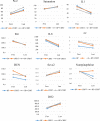Blood Purification Techniques, Inflammatory Mediators and Mortality in COVID-19 Patients
- PMID: 33959166
- PMCID: PMC8088142
Blood Purification Techniques, Inflammatory Mediators and Mortality in COVID-19 Patients
Abstract
Background: Inflammatory mediators are an important component in the pathophysiology of the coronavirus disease 2019 (COVID-19). This study aimed to assess the effects of reducing inflammatory mediators using hemoperfusion (HP) and continuous renal replacement therapy (CRRT) on the mortality of patients with COVID-19.
Materials and methods: Twelve patients with confirmed diagnosis of COVID-19 were included. All patients had acute respiratory distress syndrome (ARDS). Patients were divided into three groups, namely, HP, CRRT and HP+CRRT. The primary outcome was mortality and the secondary outcomes were oxygenation and reduction in inflammatory mediators at the end of the study.
Results: Patients were not different at baseline in demographics, inflammatory cytokine levels, and the level of acute phase reactants. Half of the patients (3 out of 6) in the HP+CRRT group survived along with the survival of one patient (1 out of 2) in the HP group. All four patients in the CRRT group died. Serum creatinine (SCr), Interleukin-1 (IL1), Interleukin-6 (IL6), Interleukin-8 (IL8), partial pressure of oxygen (PaO2), O2 saturation (O2 sat), and hemodynamic parameters improved over time in HP+CRRT and CRRT groups, but no significant difference was observed in the HP group (All Ps > 0.05).
Conclusion: Combined HP and CRRT demonstrated the best result in terms of mortality, reduction of inflammatory mediators and oxygenation. Further investigations are needed to explore the role of HP+CRRT in COVID-19 patients.
Keywords: ARDS; Acute respiratory distress syndrome; COVID-19; Continuous renal replacement therapy; Coronavirus disease 2019; Cytokine; Hemoperfusion; Inflammatory marker; Mortality; Oxygenation.
Copyright© 2020 National Research Institute of Tuberculosis and Lung Disease.
Conflict of interest statement
Competing interests Not applicable.
Figures


Similar articles
-
Hemoperfusion and blood purification strategies in patients with COVID-19: A systematic review.Artif Organs. 2021 Dec;45(12):1466-1476. doi: 10.1111/aor.14078. Epub 2021 Oct 10. Artif Organs. 2021. PMID: 34632596 Free PMC article.
-
Hemoperfusion Combined With Continuous Renal Replacement Therapy in the Management of ARDS COVID-19 Patients: A Quasi-Experimental Study.Health Sci Rep. 2025 Apr 1;8(4):e70571. doi: 10.1002/hsr2.70571. eCollection 2025 Apr. Health Sci Rep. 2025. PMID: 40177411 Free PMC article.
-
Uncertain Clinical Effect of Polymyxin B Hemoperfusion in Patients with Septic Acute Kidney Injury Requiring Continuous Renal Replacement Therapy.Shock. 2021 Oct 1;56(4):551-556. doi: 10.1097/SHK.0000000000001752. Shock. 2021. PMID: 33606479
-
Early Hemoperfusion for Cytokine Removal May Contribute to Prevention of Intubation in Patients Infected with COVID-19.Blood Purif. 2021;50(2):257-260. doi: 10.1159/000509107. Epub 2020 Jun 26. Blood Purif. 2021. PMID: 32594085 Free PMC article.
-
Clinical impact of continuous renal replacement therapy on multiple organ failure.World J Surg. 2001 May;25(5):669-76. doi: 10.1007/s002680020029. World J Surg. 2001. PMID: 11396437 Review.
Cited by
-
Hemoperfusion and blood purification strategies in patients with COVID-19: A systematic review.Artif Organs. 2021 Dec;45(12):1466-1476. doi: 10.1111/aor.14078. Epub 2021 Oct 10. Artif Organs. 2021. PMID: 34632596 Free PMC article.
-
Expanding the potential therapeutic options of hemoperfusion in the era of improved sorbent biocompatibility.Kidney Res Clin Pract. 2023 May;42(3):298-311. doi: 10.23876/j.krcp.22.223. Epub 2023 Mar 29. Kidney Res Clin Pract. 2023. PMID: 37098671 Free PMC article.
-
Hemoperfusion Combined With Continuous Renal Replacement Therapy in the Management of ARDS COVID-19 Patients: A Quasi-Experimental Study.Health Sci Rep. 2025 Apr 1;8(4):e70571. doi: 10.1002/hsr2.70571. eCollection 2025 Apr. Health Sci Rep. 2025. PMID: 40177411 Free PMC article.
References
LinkOut - more resources
Full Text Sources
Research Materials
Miscellaneous
